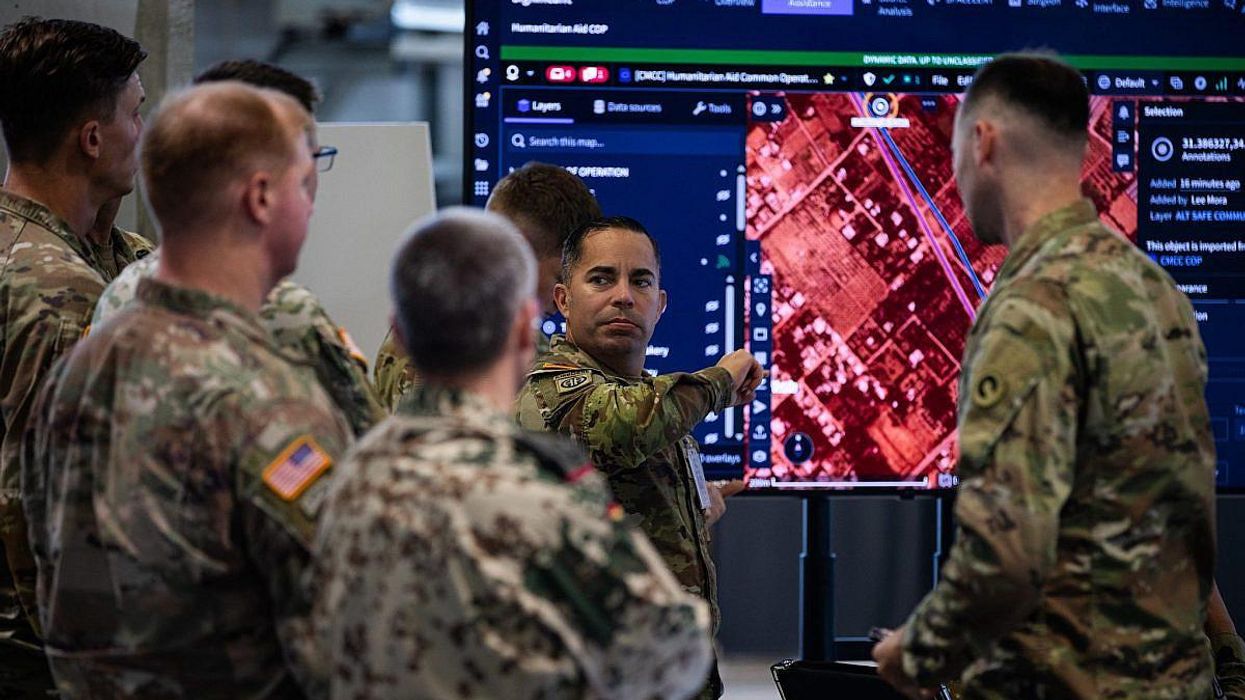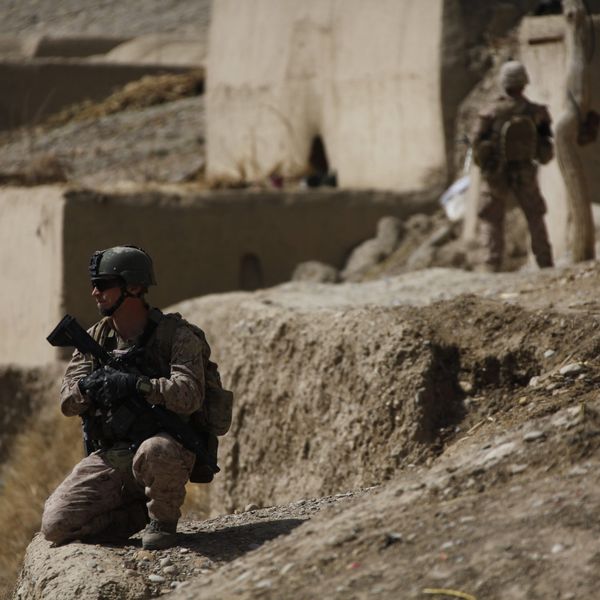U.S. Marine officers are notoriously dismissive of those who talk about strategy. "Strategy?" a Marine who served in Vietnam says. "Here was our strategy: hey-diddle-diddle, straight-up-the-middle." The description rings true: the Marine Corps’ most famous fights were straight-ahead affairs that gave the Corps its most celebrated moments: at Belleau Wood (in World War One), at Tarawa, Iwo Jima and Okinawa (in World War Two), at Inchon (during Korea), at Hue (in Vietnam) and, most recently during the battles for Fallujah, back in 2004. Now, it seems, all of that is changing.
In August of last year, Marine Corps Commandant David Berger published his Commandant's Planning Guidance, a detailed recasting of the Marine Corps’ force structure. By any measure, Berger's guidance marked a breathtaking shift away from the service's urban combat focus and its follow-on mandate of "countering violent extremists in the Middle East" to a "great power/peer level competition, with special emphasis on the Indo Pacific…" The shift, Berger admits, is sweeping: "from inland to littoral, and from non-state actor to peer competitor." The guidance reduces tank companies (from 7 to 0), artillery batteries (from 21 to 5), infantry battalions (from 24 to 21), amphibious vehicle companies (from 6 to 4), helicopter attack squadrons (from 7 to 5), and the number of F-35Bs in its air squadrons. The guidance eliminates law enforcement battalions and bridging companies. And the force itself will be cut by some 12,000 personnel over a period of ten years. More simply: Berger's guidance ("to be clear, it's not really a new strategy," one senior Marine officer notes, "it's more like a new operational concept") cuts structure in favor of adopting "long range precision fires, advanced reconnaissance capabilities, unmanned systems and resilient networks."
The shift is here to stay: Berger clamped a non-disclosure requirement on participants in the wargames that led to the rethinking and, just last week, cancelled the "Metropolis II" exercise testing tactics the Marines would adopt to fight in cities. Instead, the service will focus on building a new Marine Littoral Regiment (an MLR) that would allow it to operate on small atolls and islands against a projected threat in the Pacific — read: China. Berger's new MLR is billed as "dispersed, agile and constantly relocating" (a combat team, a logistics element and an anti-air battalion), and delivered to the battleground by a yet-to-be-designed class of amphibious ships. Dispersed and agile? For Berger's critics, the MLR looks more like a Navy landing party (of some 1800 swabees) than an all-arms 3600 trooper Marine regiment of hardcore fighters. Berger would almost certainly reject the claim, but his guidance ties his service more closely to the Navy than it has been since the Marines landed on Guadalcanal. "During World War II, we as a Service, clearly understood that Marines operated in support of the Navy's sea control mission," the guidance argues. "In subsequent years, the luxury of presumptive maritime superiority deluded us into thinking the Navy existed to support 'Marine' operations ashore. That era was a historic anomaly, and we need to re-focus on how we will fulfill our mandate to support the fleet."
Berger's guidance earned initial praise, even from would-be detractors ("it's one of the most well-written documents to come out of the Pentagon in a long while," a U.S. Army force planner admitted), as well as a host of respected military thinkers, including Dr. James Lacey, a former U.S. infantry officer and director for War, Policy, and Strategy at the Marine Corps War College. "I think Berger has boldly taken the Corps in a direction it must go as we reenter a period of great state competition," he wrote in an email. More crucially, Chris Brose, the former staff director of the Senate Armed Services Committee — whose questions to the services in 2018 helped to fuel Berger's thinking — told columnist David Ignatius that the new Marine guidance "looks reality in the face and says we've got to make changes. He doesn't hedge, he doesn't fudge. He makes choices. He's thrown down the gauntlet for the other services."
Not everyone agrees. An early and outspoken critic of Berger was James Webb, a former Marine Corps officer, Vietnam veteran and Secretary of the Navy. For Webb, the Berger guidance reads like a pointy-headed power point presentation cooked up by draft dodging Marine Corps wannabes: "Interestingly, when citing his philosophical inspiration at the outset of his proposal, General Berger chose to ignore two centuries of innovation and ground-breaking role models who guided the Marine Corps through some of its most difficult challenges," Webb wrote in a much-circulated article in The National Interest. "The giants of the past — John LeJeune, Arthur Vandegrift, Clifton Cates, Robert Barrow and Al Gray, just for starters — were passed over, in favor of a quote from a professor at the Harvard Business School who never served. Many Marines, past and present, view this gesture as a symbolic putdown of the Corps’ respected leadership methods and the historic results they have obtained."
Webb's critique is echoed by other experts, including Dr. Williamson "Wick" Murray, one of the nation's most respected defense thinkers. "The Marines are the most intellectual of all services," Murray told me in an extensive telephone interview, "so I'm a little surprised that the guidance leaves so many unanswered questions. It goes too far in stripping out capabilities, lacks important details on how these capabilities will be replaced and doesn't provide strategic solutions to strategic challenges. This guidance needs to be more nuanced and more flexible. It's not. It puts everything on the table for countering China, but if history teaches us anything it's that the enemy you get is rarely the one you plan for." Murray also notes the unease that greeted the guidance from the U.S. Navy. "The big assumption here is that the Navy wants to cooperate, that it'll be a willing partner. Maybe: but its yet to be seen whether they're capable of taking this on." A senior U.S. Navy strategist, speaking on background because of the sensitivity of the topic, agrees: "The Navy has largely ignored strategy and focused on what to buy and how to buy it, then figuring out how to use what they have." Which is to say that the Navy leadership seems strangely out of touch with what Berger is doing — a kind of hey-diddle-diddle-let's-buy-more-ships focus that retains its legacy platforms (Berger dubs them "large ships" — like aircraft carriers — "with large electronic, acoustic, or optical signatures") at the same time that the Marines are shedding theirs.
That the Navy seems relatively clueless is something of a surprise, since the Navy that was one of the first services to pivot to Asia. In 2010, Adm. Gary Roughead, the chief of naval operations and Gen. Norton Schwartz, the head of the air force, signed a classified memorandum directing their services to develop "AirSea Battle" — a new operational concept designed to overcome China's development of anti-access and area denial weapons. The idea was to find ways to preserve the U.S. military's access to the Western Pacific. “The Air Force and Navy arrived, almost simultaneously, at the same ‘aha’ moment,” defense intellectual and Navy expert Bryan McGrath told me in 2015. “They saw that there was a power rising that could challenge what each of them do best. For the Navy, that’s power projection — and for the Air Force, that’s air power. And for decades, neither of those battle spaces was in jeopardy. But suddenly, with what China was doing, that was no longer true. Suddenly, there was a power in the Pacific that was going to challenge the way they fight.” Retired U.S. Army Colonel Kevin Benson, one of his service's premier thinkers, puts it this way: "Close combat is a thing of the past," he says. "If the enemy knows where you are, he can kill you. We live in an era of hypersonic weapons and satellite-linked units. So you have to get under that umbrella, you have to look for a seam in his defenses, or you have to create one. You have to put more fire on the bad guy faster than he can respond. Berger's guidance is incomplete, but that's what he's trying to do."
Berger's thinking reflects this reality. "The rapid expansion of China’s area-denial capabilities, coupled with its pivot to the sea . . . have fundamentally transformed the environment in which the U.S. military will operate for the foreseeable future," Berger wrote in an article in War on the Rocks last December. "For the first time in a generation, sea control is no longer the unquestioned prerogative of the United States." To counter this, the Marines will deploy "low cost, lethal air and ground unmanned platforms, unmanned long range surface and subsurface vehicles, mobile, rapidly deployable rocket systems, long range precision fires, loitering munitions… mobile air defense and counter-precision guided munitions capabilities, signature management, electronic warfare and expeditionary airfields."
But while Berger's focus is on China, some Pentagon officials suspect that other realities are driving his thinking. Berger says as much one-third of the way through his guidance: "The principle challenge facing the Marine Corps today," he writes, "lies in continuing to fulfill its charter as the naval expeditionary force-in-readiness, while simultaneously modernizing the force… with potentially fewer Marines, and a possible reduction in total resources." Berger makes it clear that he's willing to "secure additional modernization dollars in exchange for force structure…" — another way of saying that the Marines are willing to live with fewer numbers so long as they get new weapons. In truth, the Marines may not have a choice: Pentagon officials concede that the services are entering an era of flatline or even plunging budget authorizations at the same time that they're having difficulty signing up and retaining new recruits. It's easy to say you're going to have fewer Marines when no one is showing up at your recruiting stations. Among Berger's critics are those who discuss his ideas while giving a wink-wink at this reality: the enemy the Marines are fighting isn't China, they say, it's the defense budget.
But suggesting that it's the budget, and not China, that is behind Berger's thinking brings often angry responses from those paid to think about naval strategy. "Usually when budgets flatline, services become conservative and double down on what they consider to be their 'core,'" the senior naval strategist to whom I spoke, says. "That's doesn't seem to be what the Marines are doing here . . . This is really just the Marines figuring out how to do their job."
Finally, the guidance's most outspoken critics, including one senior Marine who served in Afghanistan, point out that Berger plans to fight China with "units yet to be formed, transported on amphibious ships yet to be built, linked by networks yet to be developed and armed with anti-missile capabilities yet to be tested." The rejoinder from the Navy strategy expert with whom I spoke is pointed: "Does a lack of completed technology mean that you don't start pushing forward? The Marines worked on amphibious doctrine before the Higgins Boat was done [in World War Two] and worked on helicopter doctrine way before they had helos with the range and capacity to actually do it. Working on the technology hasn't stopped the Marines before."
Of course, there is also an unstated agenda here, as any number of Berger critics note. The new guidance positions the Marines as the lead service for the emergent and increasingly empowered China-is-the-enemy lobby. And while that view is far from an accepted fact, the guidance will help sell it. Or, to paraphrase one Asia expert: if you treat China like an enemy, and name them as an enemy, you're going to get what you ask for. It's a smart move for Berger and his service, but it's also transparent — and cynical: in an era of flatlining or eroding budget numbers, the Marines can not only claim to be "the first to fight," they can claim to be the first in line to get the anti-China defense dollars. Which, presumably, is exactly where Berger wants them to be.
If there is a bottom line here, it is that while Berger partisans argue that his guidance is "visionary, disruptive and transformational," his detractors use the same adjectives to highlight its weaknesses: it's too visionary, too disruptive and too transformational.
But it's also "subversive," as the Marine veteran of Afghanistan told me. "If Berger is right, if it's possible to do better with less, than why can't the Army, Navy and Air Force do the same?" he asks. "If Berger's planning guidance is the wave of the future, then why are the Army, Navy and Air Force stuck in the past?" Which suggests other, yet to be answered, questions: if aircraft carriers and other "expensive and exquisite capabilities" (as Berger describes them) are vulnerable, then why do we continue to build and deploy them? "The Navy, especially, needs to provide answers," this Marine says, "and the last time I checked, Berger's office was on the same corridor as the chief of naval operations. So if he really wants to know what the Navy thinks, all he has to do is walk down the hall and ask."
















